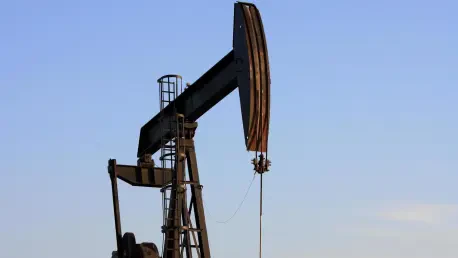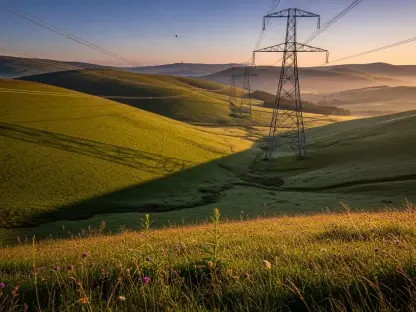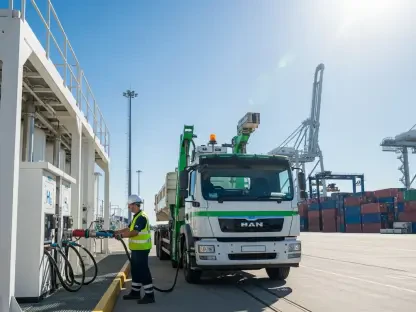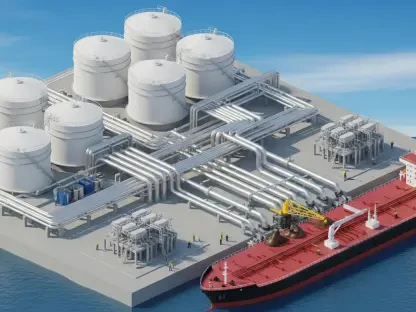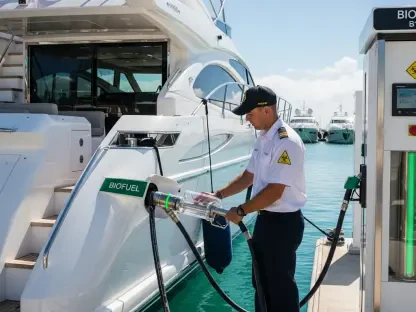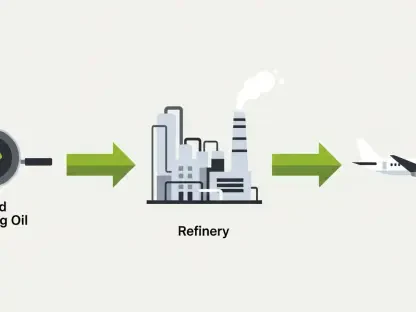What happens when a global oil giant finds itself under siege, not just by sanctions but by precision drone strikes crippling its very infrastructure? Russia, a titan in the energy market, faces this exact predicament as Ukrainian attacks have slashed its refining capacity, forcing a dramatic pivot in strategy. In August, crude oil exports surged by 200,000 barrels per day (bpd) from western ports, a desperate bid to keep revenue flowing amid chaos. This isn’t just a logistical shuffle; it’s a high-stakes balancing act that could reshape global energy dynamics. The story of this upheaval unfolds as a nation scrambles to adapt under pressure, revealing vulnerabilities and resilience in equal measure.
The significance of this shift cannot be overstated. Russia’s oil industry, a cornerstone of its economy, is caught in a vise between military conflict and Western sanctions. With domestic refineries hobbled, exporting unprocessed crude has become a lifeline, redirecting millions of barrels to international markets. This development ripples far beyond national borders, influencing oil prices, supply chains, and geopolitical tensions. Understanding this crisis offers a window into how conflict and economics collide, impacting everyone from policymakers to consumers at the gas pump.
A Strategic Pivot: Why Russia’s Oil Exports Are Spiking
In a stunning turn of events, Russia has ramped up its crude oil exports, a direct response to devastating drone strikes on its refining infrastructure. Unable to process vast quantities of crude domestically, the nation has redirected shipments through key western ports like Primorsk and Novorossiysk. This isn’t a choice born of convenience but of necessity, as the industry grapples with sudden and severe limitations.
The scale of this adaptation is staggering. With an additional 200,000 bpd hitting the market, total loadings from these ports now hover around 2 million bpd, up from an initial plan of 1.8 million. This surge reflects a calculated move to maintain cash flow while domestic capabilities are crippled, showcasing a flexibility that few could have anticipated under such duress.
Behind this strategy lies a deeper challenge: sustaining economic stability amid relentless external pressures. Sanctions already limit market access, and now military actions have compounded the strain. The decision to export more crude, rather than refine it, speaks to a short-term fix with long-term implications for both Russia and the global energy landscape.
Conflict’s Toll: How Drone Strikes Are Reshaping Russia’s Oil Sector
The Ukrainian drone campaign targeting Russian oil infrastructure has delivered a punishing blow to a vital economic artery. These strikes, far from random, have hit 10 major refineries, slashing processing capacity by 17%, or roughly 1.1 million bpd. The result is a cascading effect that disrupts not just production but the entire supply chain.
Beyond the refineries, critical nodes like the Druzhba pipeline and the Unecha pumping station have also come under attack, threatening export volumes by as much as 500,000 bpd. Ports like Ust-Luga, normally a powerhouse handling 700,000 bpd, now limp along at half capacity. These disruptions expose a fragility in an industry long seen as a bastion of strength, forcing a reevaluation of operational security.
The broader implications are impossible to ignore. As Russia struggles to maintain its role as a key energy supplier, fluctuations in output ripple through global markets. Oil prices, already volatile, face further uncertainty, while geopolitical tensions simmer. This conflict-driven crisis underscores how military actions can reverberate through economies worldwide, affecting energy security for nations far removed from the battlefield.
The Hard DatExport Surges Amid Refinery Woes
A closer look at the numbers reveals the sheer magnitude of Russia’s oil industry upheaval. The 200,000 bpd increase in exports from western ports paints a picture of urgency, with diverted volumes straining facilities at Novorossiysk and Primorsk. Meanwhile, Ust-Luga’s diminished capacity—down to 350,000 bpd—highlights the operational bottlenecks created by targeted strikes.
Refinery setbacks add another layer of complexity. The loss of 1.1 million bpd in processing power has left vast quantities of crude unrefined, pushing it toward international buyers. This isn’t a seamless transition; logistical hurdles, such as limited vessel availability, constrain the ability to fully capitalize on the export boost. The data underscores a system stretched thin by unforeseen challenges.
Further complicating matters are the hits to infrastructure like the Druzhba pipeline, a lifeline for exports to Europe. With potential reductions of half a million bpd looming, the industry faces a precarious balancing act. These figures aren’t just statistics; they represent a sector fighting to maintain relevance and revenue in the face of relentless adversity.
Insider Perspectives: Uncertainty Shadows Export Strategies
Voices from within the industry paint a grim picture of unpredictability as Russia navigates this crisis. Insiders report that repair schedules for damaged refineries shift almost daily, a direct consequence of ongoing Ukrainian strikes. This fluidity makes it nearly impossible to lock in export volumes for August or beyond, creating a planning nightmare.
Logistical constraints add fuel to the fire. Sources note that limited vessel availability toward the end of the month hampers efforts to maximize shipments, even as export targets rise. One industry expert described the situation as akin to “navigating a storm with no compass,” capturing the frustration and uncertainty that permeate every decision.
These firsthand accounts reveal a deeper tension: the clash between immediate revenue needs and the looming threat of sustained damage. While boosting exports offers a temporary salve, the lack of clarity on when—or if—key facilities will return to full capacity casts a long shadow. The human element of this crisis, the stress and speculation, brings the stakes into sharp focus.
Tactical Moves: Balancing Exports with Infrastructure Recovery
Amid the turmoil, Russia must chart a path that sustains exports while addressing critical infrastructure damage. Prioritizing operations at less-affected ports like Novorossiysk could stabilize outflows, even as Ust-Luga languishes. Redirecting shipments through alternative routes, though costly, might mitigate some losses tied to pipeline disruptions.
Another potential tactic involves accelerating repair efforts, despite the risks of further attacks. Securing international partnerships to bolster logistics—perhaps by leasing additional vessels or tapping into foreign port capacities—could ease the strain on domestic systems. These measures, while not foolproof, offer a framework for maintaining revenue under intense pressure.
Sanctions add a layer of complexity, limiting access to resources and markets. Yet, exploring deals with non-Western buyers or leveraging existing alliances may provide a buffer. The road ahead demands not just operational fixes but diplomatic finesse, as the nation seeks to preserve its economic lifeline in a hostile environment. These strategies, though speculative, highlight the multifaceted approach needed to weather this storm.
Reflecting on a Sector Under Siege
Looking back, the drone strikes that battered Russia’s oil infrastructure in August marked a turning point, exposing vulnerabilities in a sector long deemed unassailable. The surge in exports, while a clever workaround, came at the cost of domestic refining power, leaving lasting scars on operational capacity. Each attack, each redirected shipment, told a story of adaptation born from necessity.
The path forward demanded innovative solutions. Industry leaders had to consider not only how to repair physical damage but also how to fortify against future disruptions. Investments in enhanced security for critical assets, alongside diversified export channels, emerged as potential safeguards. These steps, though resource-intensive, were essential to prevent a repeat of such crippling setbacks.
Beyond immediate fixes, a broader reckoning loomed. Policymakers and energy experts needed to reassess the interplay of military conflict and economic stability, recognizing that energy infrastructure could no longer be viewed in isolation from geopolitical risks. This crisis served as a stark reminder that resilience required foresight, urging a global dialogue on securing energy supplies in an era of hybrid warfare.
